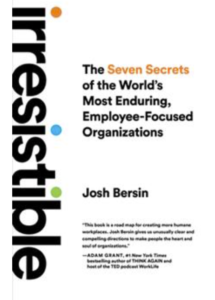Discussion with Kathi Enderes
Kathi Enderes is the SVP of Research at the HR research and advisory firm, The Josh Bersin Company. WSR editor Roy Altman talks with Kathi today about the recently released book, Irresistible: The Seven Secrets of the World’s Most Enduring, Employee-Focused Organizations by Josh Bersin.
KE: I lead all the research that we’re doing at The Josh Bersin Company, and we are an HR research and advisory company. I’ve been working with Josh and the team for two years.
WSR: Can you tell us what are the seven secrets of the world’s most enduring employee-focused organizations?
KE: Before I get into the book, let me provide some background on why this book came about. In 2008 we experienced a financial crisis and economic recession, but the subsequent 15 years have been all about growth. Not employee growth but economic growth, stock market growth, technology growth, and technology transformation. Many projects and strategies were centered around innovation, digital transformation, and business growth, while the employee side was not a significant consideration. Then the pandemic hit, and everything changed. We all were in survival mode, and the goal was to survive versus thrive. Employee issues were not on the sideline since we were in the middle of business subsistence. If people got sick, burnt out, or if they didn’t have childcare—these issues were elevated to that “irresistible” kind of view where they’re not just the sideline issues but THE most important business issues. And HR people were immediately front and center.
WSR: I’ve seen all sorts of business cycles. And the pendulum swings back and forth. For a long time, employers had the upper hand and were abusive to employees. Now the pendulum has swung back. Employees have more say in the matter. But don’t you think that once the pendulum swings back the other way, they’ll go right back to abusing their employees?
KE: We do see some tech companies going back into that mode with recent layoffs and the way they treat employees, but I don’t think it’s going to be possible to swing all the way back, because the labor market is still so tight. The population is aging, and some people just don’t want to work anymore at all. Josh Bersin was in Europe the last couple of weeks, and while he was visiting in the Netherlands, he said they were all talking about how they are going to bring people back to work when their employees’ response is: “I’m not going to work anymore at all, I’m just not doing this anymore.” Their whole perspective, influenced by the pandemic, is that life is too short. So, no, I don’t think it’s going to be possible to swing all the way back because the labor market just gets tighter and tighter. Birth rates are declining, and people are opting out of the workforce altogether. People are just basically saying, “I’m not doing full-time employment anymore. I’m just going to be a contractor and do a bunch of side hustles.” The new generation also thinks about work in a unique way. They’re not thinking about spending 40 to 60 hours every week with one company. What they’re thinking about is: “Can I go to work a little bit, and then can I go to the beach and surf? Or I might do something else.”
WSR: I know there was one chapter in the book about “do work, not jobs.” As you unpack jobs into tasks, and technology advances, you can automate a lot of those tasks that used to be in the realm of humans. Doesn’t that kind of balance out the equation a little bit?
KE: Hopefully, this will help a little bit with the equation. We did a big study on the healthcare industry, and nursing jobs are incredibly tight. We identified that in the next couple of years, every third nursing job in the U.S. is going to be empty. You will need technology and automation to close some of that gap. Even with that gap closure, you won’t be able to automate 2.1 million missing jobs; you’re still going to be out of luck. If you don’t focus on your employees and help them build careers and help them balance their workload, and make sure that they are coached by their manager – like a coach, not a boss, you’ll struggle. Technology will help, but I don’t think it’s going to replace humans. I just saw another study this morning that just came out from Burning Glass Institute, which said the number one needed skill and capability is working with AI. I don’t think the whole notion of AI replacing humans is going to happen. I think it’s going to be more working with AI through machine learning.
WSR: Hierarchies are not the way work gets done. Work gets done in networks, teams, and lots of complex structures. It is not that you don’t have hierarchies. Fast forward 15 years later, and every HR system supports only hierarchical organizational structures. Why aren’t HR software companies figuring out what Josh has been talking about and what you and I know?
KE: Companies are trying to figure that out. We did a big study on organization and work design, where we identified that the most successful companies are what we call agile and accountable. That might sound like a contradiction, but it’s really both. It is agile teams, but also being truly clear on who is accountable for what tasks and rewarding people based on what they are accountable for. We have a great case study on Bosch Power Tools, which is a German manufacturing company. Exceptionally large and German so it doesn’t strike you as probably most suited for agile. They were losing ground on power tools sales, and they said, “What’s happening here?” What they figured out is they were not in the business of selling power tools but in the fixing business. For example, attaching things to the wall kind of business, solving customer problems, not selling the tools, because, you know, when you have a hammer, everything looks like a nail. They said, well, people don’t need a hammer; they need a glue stick to get something on the wall. They broke up their functional silos where you had sales, manufacturing, and marketing and said, “We’re working on standing, customer aligned, project teams.” So now Bosch is focused on the fixing objects to the wall business, the measurement business, the drilling business, rather than saying we manufacture tools, and then nobody wants to buy them, let’s just see how we can work together in a better way. That is the notion of “We are in the business of solving customer problems,” and that applies to all kinds of businesses.
WSR: Is HR technology behind the curve in terms of supporting new organizational structures?
KE: I think a lot of vendors are, but they’re catching up. One of the big HR technology innovations that factor into that is the “talent marketplace.” Talent marketplaces are in every big HCM system. Vendors are building them on top of their legacy, hierarchical systems, as they really help with the work, not jobs, because talent marketplaces help you as an employee to connect to projects that you want to work on, and that work is often not in your functional silo. HSBC told us that 60% of the talent marketplace projects were cross-functional in nature. This puts work in the hands of the employees, and HR doesn’t have to manage it. We used to get contractors or stack work on top of full-time employees. But when we put the projects in the marketplace, they were eaten up. The problem was not getting people to adopt it, the problem was keeping the shelves stocked with projects because everybody wanted them.
WSR: I like that in every chapter of Irresistible, there’s a section on how to get started and how to get it right. Companies are slow-moving. We are still using hierarchies that were used during the Industrial Revolution. How do you get companies to embrace these principles? How do you scale this?
KE: There are diverse ways to go about this. One notable example where they just ripped off the band-aid and did it for everybody is Telstra, an Australian telecom company. They just said one day we’re going to do Agile like really be agile across the company from one day to the next because that’s the only way we can get our business back on track. That is one way to do it. It’s a little bit risky, and it’s not for everybody. Other companies might start with a business problem or business area that we can use to solve a problem. So it’s an underperforming business unit or a talent problem where you have a major talent gap. I think there’s no right or wrong answer. I think it’s just what works for your company and works for your business.
WSR: Agile is about empowering people that are closest to the work. People up the hierarchy hold all the power, and you’re asking them to give it up in the interest of other people.
KE: In the talent marketplace, every company we talked to all said that the culture change is not from the employees because they all love it. It comes from the manager’s side because the talent marketplace means you’re going to free up people’s time to work on cross-functional projects. What that means is your best performers are not going to work on your thing all the time – only work on your thing 80 percent of the time. The culture change from the management side is big.
WSR: In sports, there are statistics to measure how well the team does when one is on the field, in addition to your individual statistics, yet, in business, we only met measure individual performance.
KE: That is so true. Those companies that do reward and measure and put recognition behind team performance, not just individual performance, tend to be much more successful financially, have happier customers and employees. And it also ties to insights that we got from our employee experience study, where we identified all the things that you can do in an employee experience. And we didn’t just see this technically, but culturally as well. We looked at 85 practices, and the number one most impactful thing that it can do in employee experiences is inspiring a culture where people help each other.
WSR: Tell us about career pathways.
KE: If you read that report, the most mind-blowing story that we heard about was that these career pathways do not just happen within organizations. Tuition/cost-free education for a receptionist who wants to be a nurse is one example. That way, their job doesn’t get automated, they don’t lose their job, and the hospital or the health care system can fill these jobs. What we found out is there’s also cross-industry collaboration. Amazon has a program they call Career Choice, where they give tuition-free education for their warehouse workers whose job at some point, is going to go away due to robotics. They can then place them in hospital systems that need a lot of nurses. They don’t have to lay them off. But they also said, well, that’s a good thing to do, and they’re going to be loyal to Amazon for life. And if they have more money, they’re going to spend it on Amazon! I thought that was interesting because it’s not just altruistic, it makes good business sense too. DEI (Diversity, Equity, and Inclusion) is a big theme there too. Because if you think about it, a lot of the warehouse workers might be in underrepresented groups. They might be people that have never had a degree or a formal education. Many of these workers say things like, “I’m showing my kids that it’s possible for us to get an education and to have an educated job that creates a role model in the community as well.” These are powerful stories.



